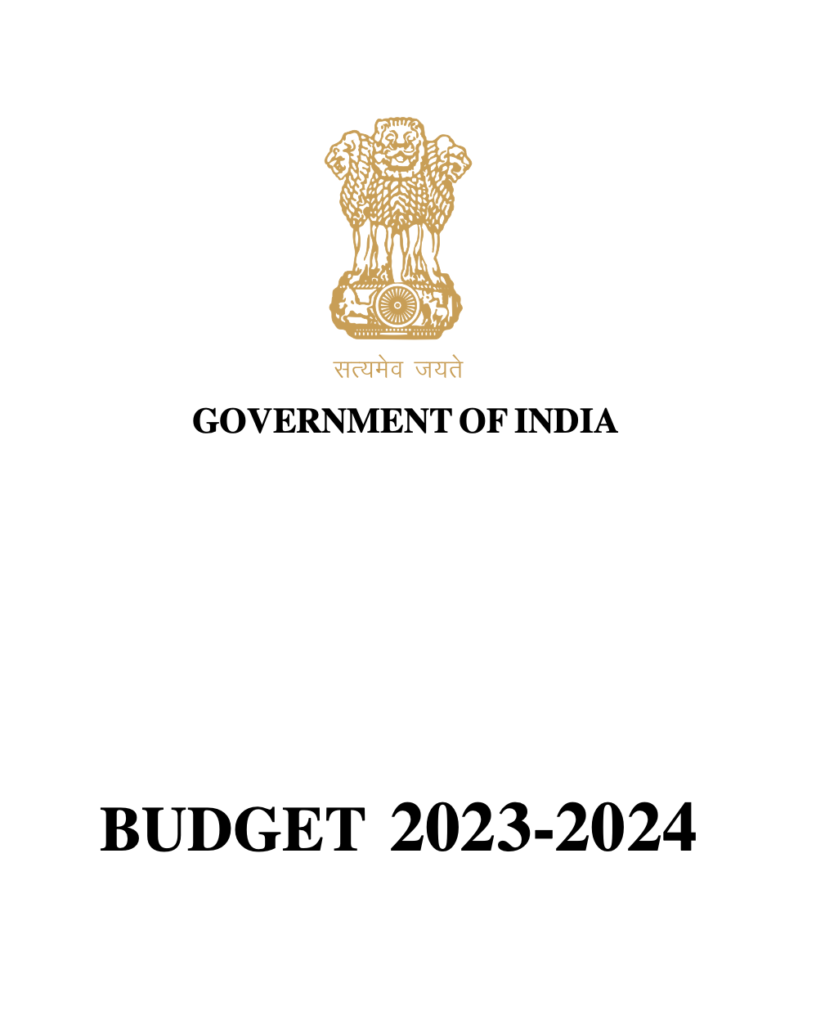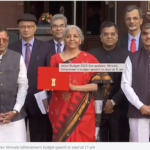The Fifth Budget under Modi Government 2.0 was presented on Wednesday by Union Finance Minister Nirmala Sitharaman. The Indian economy is on the right track and is equipped for a bright future, according to Nirmala Sitharaman, who made this statement in the final comprehensive budget before the general elections next year. Sitharaman highlighted significant modifications to the tax slabs under the new tax regime as well as a significant increase in the funding for railways and capital expenditures, which will greatly benefit taxpayers and the economy.
The following is a full reading of the numerous initiatives of Finance Minister Sitharaman unveiled in the Budget 2023, subdivided by sectorwise :
Old Tax System for Taxpayer
- The previous tax system has not changed.
- The new tax system will take precedent over all others. The old tax system is still an option for citizens, though.
- In the new tax law, there is no tax on income up to Rs 7.5 lakh per year (with inclusion of standard deduction)
- In the new tax system, the government wants to lower the maximum surcharge rate from 37% to 25%.
New Tax Regimes and New Income Tax Slabs:
| Annual Income (In Rupees) | Income Tax Rate |
| Income Upto Rs. 3 Lakhs | Nil |
| Income Between Rs. 3 Lakhs to 6 Lakhs | 5% |
| Income Between Rs. 6 Lakhs to 9 Lakhs | 10% |
| Income Between Rs. 9 Lakhs to 12 Lakhs | 15% |
| Income Between Rs. 12 Lakhs to 15 Lakhs | 20% |
| Income Exceeding Rs. 15 Lakhs | 30% |
- Taxes for an individual making Rs 9 lakh a year will only be Rs 45,000: Sitharaman, FM
- Tax on income of Rs 15 lakh is reduced to Rs 1.5 lakh from Rs 1.87 lakh.
- A basic deduction of Rs 50,000 has been made available to taxpayers under the new system.
- Payment from the Agniveer Corpus Fund received by Agniveers will be exempt.
- Insurance policies with premiums over Rs. 5 lakh are no longer free from taxes.
- The government wants to make sure that net wins from online games are taxed at the moment of withdrawal or at the end of the fiscal year by instituting TDS.
- Tax-free leave encashment for non-government salaried workers has increased from Rs 3 lakh to Rs 25 lakh.
- The TDS on cash withdrawal would have a greater cap of Rs 3 crore for cooperative organisations.
- A new version of the Common IT Return Form will be released for the benefit of taxpayers.
- Mechanism for resolving complaints should be strengthened.
- In non-PAN circumstances, the TDS rate on the taxable component of EPF withdrawal would be lowered from 30% to 20%.
- 16% tax increase on some cigarettes due to indirect taxes
- Up to March 2024, new cooperatives that start production would pay 15% less in taxes.
- Glycerine and crude oil now only carry a 2.5% general customs charge.
- Silver bar import taxes increased to match those of gold and platinum
- Customs tax reductions on imports of mobile phone parts should be extended by a year.
- Customs duty on open TV panel cells has been cut to 2.5% in order to encourage TV production.
- Providing relief for customs Import taxes on certain components and inputs, such as camera lenses
- Extension of the year-long concessional duty on lithium-ion batteries
- Reduced from 21 to 13 the number of basic custom duty rates on goods other than textiles and agricultural products. As a result, there are minimal tax modifications for several goods, including toys, bicycles, and cars.
- announcements about savings plans
- The Senior Citizen Savings Scheme’s maximum deposit amount would increase from Rs. 15 lakh to Rs. 30 lakh.
- Increased to Rs. 9 lakh and Rs. 15 lakh for joint accounts, the Monthly Income Scheme cap
- Mahila Samman Saving Certificate, a one-time new saving programme for women, will be made available for 2 years, through March 2025.
- It would provide a deposit facility of up to Rs 2 lakh for a 2-year term with a fixed interest rate of 7.5% and the option of a partial withdrawal in the name of women or girls.
- railways receive a major boost
- In FY24, a budget of Rs 2.4 lakh crore was allocated for the railroads.
- It is about nine times higher than the allocations for FY14 and is the highest allocation for Railways ever.
- This year, a total of Rs 17,296.84 crore has been allotted for track renewal, up from Rs 15,388.05 crore in RE 2022-23.
- By August 2023, the Railways would probably have introduced 75 Vande Bharat trains.
- For the third year in a row, Capex increased capital investment by 33%, or Rs. 10 lakh crore, to increase economic potential and job creation, attract private investment, and act as a buffer against global headwinds.
- The centre will effectively spend Rs 13.7 lakh crore on capital.
- 3.3% of GDP is projected for capital expenditure in FY24.
- In FY24, the Center’s actual capital expenditures were Rs 13.7 lakh.
- In order to increase options for private investment in infrastructure, a new Infrastructure Finance Secretariat has been established.
- Budget for defence grew by 13% to Rs 5.94 lakh crore from Rs 5.25 lakh crore last year.
- For capital expenses, including the procurement of new weapons, aircraft, warships, and other military equipment, Rs 1.62 lakh crore has been set aside.
- The budgetary allotment for capital outlay for 2022–2023 was Rs. 1.52 lakh crore.
- The Border Roads Organization’s capital budget increased to Rs 5,000 crore.
- The Indian Air Force’s capital expenditure was the largest, coming in at Rs 57,137.09 crore.
- The Indian Navy received a capital outlay budget of Rs 52,804 crore.
- The Army’s capital expenditure is estimated to reach Rs 37,241 crore.
- The amount allotted to the Defence Research and Development Organization (DRDO) is estimated at Rs 23,264 crore.
- Fiscal position: By 2025–2026, a fiscal deficit of less than 4.5% is desired.
- In the Revised Estimate for FY23, the fiscal deficit objective of 6.4% was maintained; it was cut to 5.9% for FY24. Gross market borrowing was estimated at Rs. 15.43 lakh crore for FY24.
- The revised estimate for FY23 net tax collections is Rs 20.9 lakh crore.
- The updated estimate for total expenditures for FY23 is Rs. 41.9 lakh crore, and the revised estimate for total receipts other than borrowing for FY23 is Rs. 24.3 lakh crore.
- MSME
- A revised loan guarantee for MSMEs will go into effect on April 1, 2023, and a corpus of Rs 9,000 crore will be added.
- The programme would permit an additional Rs 2 lakh crore of collateral-free guaranteed lending while also lowering the cost of the credit by roughly 1%.
- Banking: To enhance bank governance, the government has proposed changes to the Banking Regulation Act.
- Employment: The government will begin Pradhan Mr. Mantri Kaushal The Vikas Yojana 4.0
- 30 Skill India International Centers will be built throughout various States to prepare young people for opportunities abroad.
- A pan-India National Apprenticeship Promotion Scheme called Direct Benefit Transfer will be implemented to offer stipend support to 47 lakh young people over the course of three years.
- Clean Energy: Priority Capital of Rs 35,000 crores for the Energy Transition
- Battery storage will be informed about the green credit programme under the Environmental Protection Act.
- Government to finance installation of 4,000 MwH of battery energy storage
- With a budget of Rs 19,700 crore, the National Green Hydrogen Mission will aid in the transition to a low carbon economy, reduce reliance on fossil fuel imports, and position the nation to take the lead in both technology and the market.
- Gems and Jewelry: A five-year research and development grant will be given to one of the IITs to promote the domestic manufacturing of lab-grown diamonds.
- In Part-B of the budget paper, a proposal to evaluate the customs duty on lab-grown diamonds is to be included.
- Aviation & Highways: To increase regional air connection, 50 more airports, helipods, water aero drones, and sophisticated landing grounds will be revived.
- The roads sector will have an increased outlay of Rs 2.70 lakh crore under the Union Budget 2023–24.
- For 2023–2024, the amount allotted to NHAI increased by 13.90% to Rs 1.62 lakh crore.
- Ease of Doing Business: The government will introduce a new dispute settlement plan To resolve business disagreements, use Vivad Se Vishwas 2.
- PAN as the universal identification for all Government entities’ digital systems
- Using digi locker and Aadhaar as the foundational identity, a one-stop solution for reconciling and updating identity stored by many authorities would be built.
- For a quicker response when businesses submit forms under the Companies Act, a central processing centre will be established. For commercial establishments required to have a PAN, the PAN will serve as a standard identifier for all digital systems of certain government entities.
- To make doing business easier, approximately 3,400 law provisions have been decriminalised and over 39,000 compliances have been lowered.
- To advance trust-based governance, the Jan Vishwas Bill to alter 42 Central Acts has been introduced.
- The Finance Minister has announced a number of initiatives to boost commercial activity in GIFT City.
- Electronic services
- Expanding the scope of services offered by DigiLocker
- Engineering colleges will establish up 100 labs for researching 5G applications.
- Precision farming, smart classrooms, and healthcare applications will all be covered in labs.
- Projects to launch Phase 3 of E-courts with an investment of Rs 7,000 crore
- Leading business actors will collaborate to create scalable solutions for the health, agricultural, and other sectors.
- The government would spend Rs 10,000 crore annually on an urban infrastructure development fund.
- Cities to be incentivised to improve creditworthiness for municipal bonds
- Sewers and septic tanks will be completely transitioned in all cities and municipalities.
- Health: The Union Budget Mission’s allocation for the health sector is Rs 89,155 crore, with the goal of eradicating sickle cell anaemia by 2047.
- The industry will be encouraged to make research investments as a result of the formulation of a new pharmaceutical research programme.
- The Department of Health and Family Welfare will receive 86,175 crores of the total budget of Rs. 89,155 crores, while the Department of Health Research will receive 2,980 crores.
- The Pradhan Mantri Swasthya Suraksha Yojana will have a budget of Rs 3,365 crore year 2023–2024.
- The National Health Mission’s budget allocation has grown from Rs 28,974.29 crore, one of these central sector initiatives.
- The AYUSH ministry’s budget allotment has increased from Rs 2,845.75 crore.
- The National Digital Health Mission’s budget has gone from Rs 140 crore to Rs 341.02 crore.
- Budgetary support for the National Tele Mental Health Programme has increased from Rs 121 crore to Rs 133.73 crore.
- Budgetary support for autonomous entities increases from Rs. 10,348.17 billion in 2022–23 to Rs. 17,322.55 billion in 2023–24.
- Increased from Rs 2,116.73 crore to Rs 2,359.58 crore, the ICMR’s budget.
- Housing: PM Awaas Yojana spending increased by 66% to more than Rs 79,000 crore.
- Continued interest-free lending to states
- Center will go on 50-year loan to state governments with an additional year of no interest
- Setup of a Children’s and Teens’ Digital Library:
- A national digital library will be established for kids and teenagers.
- Digital libraries will get new non-curricular titles in regional languages and English from the National Book Trust and Children’s Book Trust.
- At the panchayat and ward levels, states are urged to establish physical libraries for them and to provide the necessary infrastructure for them to access the National Digital Library’s resources.
- Education: Three artificial intelligence centres of excellence will be established in leading universities.
- Alongside the 157 medical colleges that have already been operating since 2014, 157 new nursing colleges will also be founded.
- In the upcoming three years, Eklavaya Model Residential Schools will be established. 38,800 teachers and support staff will be hired by the Center to work in 740 schools that will serve 3.5 lakh tribal students.
- A national data governance policy will be released to encourage scholarly and entrepreneurial research and innovation.
- A grant increase of Rs 459 crores has been made to the University Grants Commission (UGC) (9.37 pc).
- In comparison to BE 2022–23, support for Central Universities has increased by 17.66%, for Deemed Universities by 27%, IITs by 14%, and NITs by 10.5%.
- Agriculture: To support agri-startups by young entrepreneurs, an agriculture accelerator fund will be established.
- The development of digital public infrastructure for the agricultural industry
- Agriculture credit worth 20 lakh crore would be used for dairy, fishery, and animal husbandry.
- One crore farmers would receive aid to switch to natural farming during the next three years.
- There will be 10,000 bio input resource centres created.
- To develop a sub-scheme under the PM Mastya Sampada Yojna with an investment of Rs 6,000 crore in order to further facilitate fishermen’s activities.
- The Indian Institute of Millet Research, Hyderabad, would be promoted as the Center of Excellence for Sharing Best Practices, Research, and Technologies at the International Level in order to make India a global hub for “Shree Anna”
- Computerization of 63,000 credit organisations will cost Rs. 2,516 billion.
- The upper Badra project would receive national funding of Rs. 5,300 crore to offer sustainable micro-irrigation in Karnataka’s central, drought-prone districts.
- Under the GOBARdhan (Galvanizing Organic Bio-Agro Resources Dhan) project, 500 new “waste to wealth” plants would be built with a total investment of Rs 10,000 crore.
- All businesses that market natural and biogas will be required to use 5% compressed biogas.
- Tribal Welfare: The Pradhan Mantri Primitive Vulnerable Tribal Group (PMPVTGS) programme has been established to improve the socioeconomic status of PMPVTGS Tribes by providing Rs 15,000 crore over the following three years for safe housing, sanitization, drinking water, and power.
- Department of Space – Amount allotted to the Department of Space: Rs. 12,544 crore.
- IN-SPACE’s Capital Expenditures-
- As opposed to the Rs 21 crore in the Revised Estimate, Space is allocated Rs 95 crore. 53 crore rupees from the budget have been set aside for IN-SPACe’s capital expenses.
- An allocation of Rs 408.69 crore has been given to the Physical Research Laboratory.
- Sports: A budget of Rs 3,397.32 crore, an increase of Rs 723.97 crore, is allocated to sports.
- The country’s highest-ever sports budget allocation is Rs 3,397.32 crore.
- Rs 1,045 crore has been allocated for “Khelo India.”
- For 2023–2024, Sports Authority of India would receive Rs. 785,52 crore.
- The National Sports Federations get a 325 crore rupee raise.
- PM Vishwa Karma Kaushal Samman: A package of support for traditional craftsmen and crafters has been developed, allowing them to increase the calibre, scope, and market for their goods while integrating into the MSME value chain.



